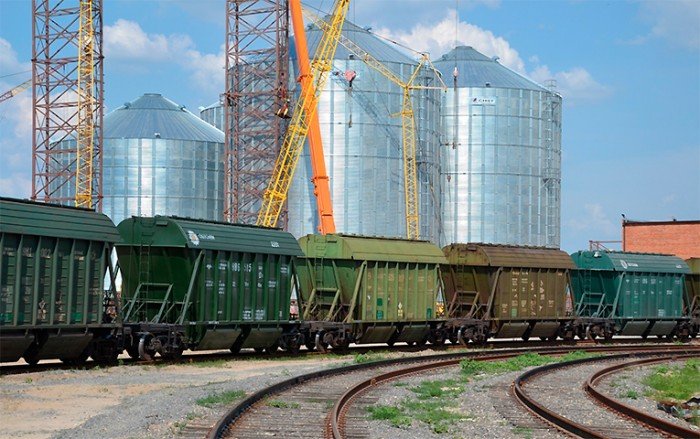Canada: Grain movement looks good but faces challenges

Grain movement has been on track this crop year despite some challenges, but it hasn’t been as good as last year, according to Canada’s grain monitor.
“There has been so much stuff that has happened this year that has confounded the movement,” said Quorum Corp. president Mark Hemmes.
The first challenge was the dip in grain prices to start the year compared to the sky-high prices of the previous couple of years.
“A lot of producers were reticent about delivering,” he said.
Grain company margins were thin due to the slumping prices, and they were also being cautious about moving product.
Fortunately, there was great winter weather and grain started “chugging along” through the system until it slowed due to a series of railway labour issues.
“For the first time I almost came to (the railways’) defense, and I say almost,” Hemmes said with a laugh.
“I feel for them.”
Grain is back to flowing nicely again as the crop year comes to an end.
“Last week we saw 10 vessels getting loaded,” said Hemmes.
“Normally in June you’re starting to see that number go down to six or seven.”
All in all, he considers it a decent year for grain movement, although car cycles will be longer than they were last year.
“You can point to the labour issue for that, mostly,” he said.
Last year was a stellar one for grain movement, according to Quorum’s 2022-23 Crop Year Annual Report.
It took an average of 40.4 days for grain to move from the Prairies to export position that year, a 34.4 per cent decrease from the 61.6-day average posted a year earlier.
“This average ranked as the lowest yet recorded under the GMP (Grain Monitoring Program) and 40.7 per cent below the 68.1-day average first benchmarked in the base year,” Quorum stated in the report.
However, Hemmes said the year-to-year comparison needs to be taken with a grain of salt because 2021-22 was a highly abnormal year.
That was the year of the big drought that slashed production on the Canadian Prairies. Grain companies and railways that were ready to handle a big crop suddenly had to shift gears and started laying off employees.
Grain sat in country elevators as elevator companies scrambled to gather enough good quality wheat and durum to meet sales specifications.
Catastrophic flooding in British Columbia’s Fraser Valley damaged transportation infrastructure serving the Port of Vancouver. Fires burned down key bridges, and rail lines were blocked with debris.
It’s no wonder why 2022-23’s performance numbers look so much better.
The 21.2-day year-over-year improvement in grain movement to the West Coast was largely the product of a 14.1-day reduction in country elevator storage times and a six-day drop in terminal elevator storage times.
The railways’ loaded transit times also fell by 1.1 days due to a “less problematic” year than 2021-22.
“Generally, it was a good year from all aspects,” said Hemmes.
“The railways were ticking right along; prices were great, and the vessels were flowing through.”
Total grain supply swelled to 79.2 million tonnes that year compared to the drought-ravaged 57.4 million tonne crop the previous year.
Western Canadian producers ultimately delivered 61.1 million tonnes of that grain into the handling system, 43.6 per cent more than the previous crop year.
“The more volume, the better the system runs,” he said.
Railways were forced to pull their hopper cars out of storage, pressing nearly 98 per cent of their fleets into active service by November 2022.
“The effects were visible in noticeably lower average car cycles on movements within Western Canada, which declined by 21.5 per cent to 14 days from 17.8 days a year earlier,” Quorum stated in its annual report.
“This denoted the lowest average observed since the 2015-16 crop year.”
Hemmes expects average grain movement time to the West Coast to be somewhere in the mid-40-day range in 2023-24.
But what about for the new crop year beginning Aug. 1?
He said the 2024-25 crop is shaping up to be another good one, but he is reluctant to make any prognostications on grain movement before the new crop year even starts.
“The moment you say something about that, the moment it all goes in the toilet,” he said.
However, he did say September and October could provide a nice start to the 2024-25 grain movement season the way things are looking right now.
“The only thing that could mess it up is a railway strike,” said Hemmes.
Read also
Official Release – December 17th! Crop & Price Navigator 2026/27
Ukraine’s harvest nears completion: Total grain output exceeds 56 mln tons
Wheat heads for worst week since June on global oversupply
‘Soybean GPT’ lands South Korea’s agriculture ministry in awkward situation
Thailand purchases 65 thsd tons of Argentine feed wheat
Write to us
Our manager will contact you soon



